
A rule of thumb concerning individuals and stories from the Old West is that you need to navigate a lot of bullshit to reach the truth. Generally, the more famous the event or its participants, the more embellished the narrative.
It was an era that lacked trustworthy photography or reporting, and word sure traveled slow. By time stories hit the printed page, they’d already often gone through a few layers of exaggeration. And by time they were retold to the masses in dime novels designed to turn a buck, they were often pure fiction wrapped around a kernel of fact.
Such is the case with the so-called “gunfight” at the O.K. Corral in Tombstone, Arizona, on October 26, 1881. A group of lawmen led by Doc Holliday, Virgil Earp, and his brothers Wyatt and Morgan, faced off against a group of outlaws called The Cowboys—including Billy Claiborne, Ike and Billy Clanton, and Tom and Frank McLaury.
The action lasted all of 30 seconds, but the story has been told and retold going on a century and a half. It’s now regarded as the most famous shootout of the Old West. The story represents a time and place when outlaws roamed free, only opposed by a few stalwart defenders of the peace.
But here’s my gripe. Pretty much nobody knew about that half-a-minute shootout in a dusty Arizona silver town until 1931—two years after Wyatt Earp died. That year, Stuart Lake published the biography “Wyatt Earp: Frontier Marshal.” It included a vivid retelling of the O.K. Corral incident. It also told people about Wyatt Earp’s legendary revolver, the Buntline Special.
According to Lake, dime novelist Ned Buntline commissioned Colt for the production of five long-barreled revolvers that were named Buntline Specials after the author. Lake says the guns were then presented to five lawmen in appreciation for their help with Buntline’s stories, including one going to Earp.
The problem is the guns most likely never existed. There’s no secondary source for any Buntline Special before Lake’s book was published, let alone one in Earp’s possession.
But that didn’t matter. The idea of a legendary lawman like Earp having a special revolver was like Arthur and his sword Excalibur. It just stuck.
Following the book’s success, various long-barreled Colts were called Buntline Specials. Colt even gave the name to a line of second-generation SAA revolvers released in the 1950s. And once the story of the most famous gunfight of the Old West made it to the silver screen, so did the Buntline Special.

What Wyatt Earp Carried in Movies and TV
Until the 1950s, the famous shootout didn’t even have a household name. Hell, the gunfight didn’t really even happen at the O.K. Corral. It broke out in a wide alley six doors down from the rear entrance to the corral.
The first movie to be adapted from Lake’s book was “My Darling Clementine” (1946) directed by John Ford. It didn’t mention the special revolver or the gunfight by its common name. In 1957, the film “Gunfight at the O.K. Corral” was released at the peak of America’s fascination with the Old West. The film’s title popularized the shootout’s now-ubiquitous moniker. There was even a song—and it also included the Buntline Special.
In this classic old-school Western, Burt Lancaster stars as Wyatt alongside Kirk Douglas as Doc, John Hudson as Virgil, and DeForest Kelley as Morgan. Wyatt uses a Colt single-action Army revolver with a 4.75-inch barrel for most of the movie, but he breaks out a different SAA with a 12-inch barrel that he says was made custom for him by Ned Buntline. This deviates even from Lake’s bogus narrative.
When Wyatt is showing the gun off to Charlie Bassett (Earl Holiman) and he asks him if the barrel is too long, Wyatt answers, “No. Good balance. Just right.” He then attaches a buttstock to the revolver and aims it like a carbine to justify the absurdly long barrel.
While the Buntline Special certainly didn’t make it into all or even most big-screen movies featuring Wyatt, it was pretty heavily emphasized on various TV Westerns in the ’50s and ’60s.
An episode from the black-and-white show “The Life and Legend of Wyatt Earp” (1955-1961) bears this description: “A little man with a brash manner and a large gun visits Wichita hoping to interest Marshal Earp in joining a Wild West Show. He provides Earp with a new gun that becomes a Wyatt Earp trademark—his Buntline Special.”
In most movies, Earp simply carries a Colt SAA Artillery or Cavalry model. The next major motion picture to feature the Buntline Special was most people’s favorite, “Tombstone” (1993) with Kurt Russell playing the legendary lawman.
The first half of the movie sees Earp trying to make his way as a saloon owner and businessman in the boomtown of Tombstone. As such, he isn’t generally armed with a pistol. With his reputation, it’s probably best not to attract gunfighters wanting to make names for themselves. When Wyatt goes for a ride in the country, he wears a top-break Smith & Wesson Schofield revolver with a nickel finish, which we usually see his brother, Virgil, carrying.
When tensions rise in town and Wyatt knows a fight is coming, he retrieves his gun from a velvet lined case he keeps in a drawer. It’s indeed a Colt SAA with a 12-inch barrel, but in this movie, it includes a small plaque on the grip. It says that the special Peacemaker was bestowed on Earp by the “grateful people of Dodge City” in April 1878. Dodge City, Kansas, is where Earp made a name for himself as a lawman. Cimarron Firearms even makes a replica of this version of the Buntline Special today.
In the more realistic “Wyatt Earp,” released soon after “Tombstone,” Kevin Costner plays Wyatt. Since the movie follows him through most of his life, he carries a number of pistols, including an 1858 Army, two Colts, and a Remington 1875 revolver, but no special-made, long-barreled Colt. However, for the gunfight in “Tombstone”, he’s carrying a Peacemaker with a 7.5-inch barrel, which is not a diminutive revolver.

What Wyatt Earp Carried in Real Life
So, what were Earp’s real guns? The short answer is nobody knows for sure. There have been a number of guns purported to be owned by him—some have even been auctioned off with that claim. Many of them were also miraculously owned by him during the right timeframe so that they could have been used in the most famous gunfight of all time.
Some have been Colt single-action Army revolvers of various barrel lengths. Another was a top-break Smith & Wesson Model 3, later known as the Schofield Revolver.
But the authenticity of every Wyatt Earp gun has been contested, and each provides flimsy providence for their claims of having ridden in his holster.
With that said, it seems likely that Wyatt carried a longer-barreled gun for at least for some of his life. There are various stories from a number of sources that say he was fond of “buffaloing” to subdue lawbreakers—that means hitting them hard over the head with the barrel of a revolver. This would certainly be easier to accomplish with a gun that had a bit more heft.
But in the end, it doesn’t really matter. Earp likely carried a good number of pistols, rifles, and shotguns during his life. We have to realize that for most folks in the Old West, even famous “gunfighters,” guns were tools to be used. It was far more important that they work when called upon than any special features or fancy name. Wyatt Earp never seemed to take time or interest to let people know what kind of revolver he preferred, so we probably shouldn’t care much either. Now, that’s not to say it didn’t matter to him. Earp did provide some insight on how he thought about gunfights during a 1910 interview:
“The most important lesson I learned from those proficient gunfighters was the winner of a gunplay usually was the man who took his time. The second was that, if I hoped to live long enough on the frontier, I would shun flashy trick-shooting—grandstand play—as I would poison.
“I was a fair hand with pistol, rifle, or shotgun, but I learned more about gunfighting from Tom Speer’s cronies during the summer of ’71 than I had dreamed was in the book. Shooting, to them, was considerably more than aiming at a mark and pulling a trigger. Models of weapons, methods of wearing them, means of getting them into action and operating them, all to the one end of combining high speed with absolute accuracy, contributed to the frontiersman’s shooting skill.
“The sought-after degree of proficiency was that which could turn to most effective account the split-second between life and death. Hours upon hours of practice, and wide experience in actualities supported their arguments over style.
“When I say that I learned to take my time in a gunfight, I do not wish to be misunderstood, for the time to be taken was only that split fraction of a second that means the difference between deadly accuracy with a six-gun and a miss. It is hard to make this clear to a man who has never been in a gunfight.”
As a non-gunfighter myself, I’ll have to take his word for it. But as a fan of Old Westerns and old guns, I wish he would have just told us how long that pistol barrel really was.




